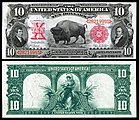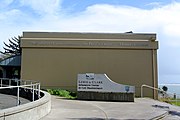Results
The Corps met their objective of reaching the Pacific, mapping and establishing their presence for a legal claim to the land. They established diplomatic relations and trade with at least two dozen indigenous nations. They did not find a continuous waterway to the Pacific Ocean.[60]
Geography and science
Further information: List of species described by the Lewis and Clark Expedition
The Lewis and Clark Expedition gained an understanding of the geography of the Northwest and produced the first accurate maps of the area. During the journey, Lewis and Clark drew about 140 maps. Stephen Ambrose says the expedition "filled in the main outlines" of the area.[61]
The expedition documented natural resources and plants that had been previously unknown to Euro-Americans, though not to the indigenous peoples.[62] Lewis and Clark were the first Americans to cross the Continental Divide, and the first Americans to see Yellowstone, enter into Montana, and produce an official description of these different regions.[63][64] Their visit to the Pacific Northwest, maps, and proclamations of sovereignty with medals and flags were legal steps needed to claim title to each indigenous nation's lands under the Doctrine of Discovery.[65]
The expedition was sponsored by the American Philosophical Society (APS).[66] Lewis and Clark received some instruction in astronomy, botany, climatology, ethnology, geography, meteorology, mineralogy, ornithology, andzoology.[67] During the expedition, they made contact with over 70 Native American tribes and described more than 200 new plant and animal species.[68]
Jefferson had the expedition declare "sovereignty" and demonstrate their military strength to ensure native tribes would be subordinate to the U.S., as European colonizers did elsewhere. After the expedition, the maps that were produced allowed the further discovery and settlement of this vast territory in the years that followed.[69][70]
In 1807, Patrick Gass, a private in the U.S. Army, published an account of the journey. He was promoted to sergeant during the course of the expedition.[71] Paul Allen edited a two-volume history of the Lewis and Clark expedition that was published in 1814, in Philadelphia, but without mention of the actual author, banker Nicholas Biddle.[72] [note 3] Even then, the complete report was not made public until more recently.[73] The earliest authorized edition of the Lewis and Clark journals resides in the Maureen and Mike Mansfield Library at the University of Montana.
Encounters with Native American nations
One of the primary objectives of the expedition as directed by President Jefferson was to observe and record the whereabouts, lives, activities, and cultures of the various American Indian tribes that inhabited the newly acquired territory and the northwest in general. The expedition encountered many different tribes along the way, many of whom offered their assistance, providing the expedition with their knowledge of the wilderness and with the acquisition of food. Along with the standard provisions of weapons, powder, tools, and cooking utensils, the expedition also had blank leather-bound journals and ink for the purpose of recording such encounters, as well as for scientific and geological information. They were also provided with various gifts of medals, ribbons, needles, mirrors and other artifacts which were intended to ease any tensions when negotiating their passage with the various Indian chiefs they would encounter along their way. As many of the tribes had had previous friendly experiences with British and French fur traders in various isolated encounters along the Missouri and Columbia Rivers, the expedition subsequently did not encounter any hostilities with the exception of the Teton-Sioux tribe under Black Buffalo [note 4] and the Partisan tribe on September 25, 1804. Both of these tribes were rivals and hoped to use the expedition to their own advantage and who both demanded tribute from the expedition for their passage over the river at that particular juncture. Captain Lewis made his first mistake by offering the Sioux chief gifts first, which insulted and angered the Partisan chief. Communication was difficult since the expedition's only Sioux interpreter, Pierre Dorion, had stayed behind with the other party and was also involved with diplomatic affairs with another tribe. Consequently, both chiefs were offered a few gifts, but neither was satisfied. At that point, some of the warriors from the Partisan tribe then took hold of their boat and one of the oars. Lewis took a firm stand, ordering a display of force, presenting arms; Captain Clark, by gesture of brandishing his sword, threatened violent reprisal. Just before the situation erupted into a violent confrontation, Black Buffalo ordered his warriors to back off. After the ensuing diplomacy and with the aid of better gifts and now a bottle of whiskey, of which some was consumed, the captains were able to negotiate their passage through without further incident. During the next two days, the expedition made camp not far from Black Buffalo's tribe. When they attempted to leave, other similar incidents occurred, but they were averted with still more gifts, this time, of tobacco.[74][75][76][77]
Observations
As the expedition encountered the various Indian tribes during the course of their journey, they observed and recorded information regarding their lifestyles, customs, and the social codes by which they lived, as directed by President Jefferson. By western standards, the Indian way of life seemed harsh and unforgiving as witnessed by members of the expedition. After many encounters and camping in close proximity to the Indian nations for extended periods of time during the winter, they soon learned first hand of their customs and social order.
Sacagawea
Main article: Sacagawea
Sacagawea, sometimes called Sakajawea or Sakagawea (c. 1788 – December 20, 1812), was a Shoshone Indian woman who arrived with her husband Toussaint Charbonneau on the expedition to the Pacific Ocean.
On February 11, 1805, a few weeks after her first contact with the expedition, Sacagawea went into labor which was slow and painful, so the Frenchman Charbonneau suggested she be given a potion of rattlesnake's rattle to aid in her delivery. Lewis happened to have some snake's rattle with him. A short time after administering the potion, she delivered a healthy boy who was given the name Jean Baptiste Charbonneau.[78][79]
When the expedition reached Maria's River, on June 16, 1805, Sacagawea became dangerously ill. She was able to find some relief by drinking mineral water from the sulphur spring that fed into the river.[80]
Though she has been discussed in literature frequently, much of the information is exaggeration or fiction. Scholars say she did notice some geographical features, but "Sacagawea...was not the guide for the Expedition, she was important to them as an interpreter and in other ways."[81] The sight of a woman and her infant son would have been reassuring to some indigenous nations, and she played an important role in diplomatic relations by talking to chiefs, easing tensions, and giving the impression of a peaceful mission.[82][83]
In his writings, Meriwether Lewis presented a somewhat negative view of her, though Clark had a higher regard for her, and provided some support for her children in subsequent years. In the journals, they used the terms "squar" and "savages" to refer to Sacagawea and other indigenous peoples.[84]
Aftermath
Two months passed after the expedition's end before Jefferson made his first public statement to Congress and others, giving a one-sentence summary about the success of the expedition before getting into the justification for the expenses involved. In the course of their journey, they acquired a knowledge of numerous tribes of Indians hitherto unknown; they informed themselves of the trade which may be carried on with them, the best channels and positions for it, and they are enabled to give with accuracy the geography of the line they pursued. Back east, the botanical and zoological discoveries drew the intense interest of the American Philosophical Society who requested specimens, various artifacts traded with the Indians, and reports on plants and wildlife along with various seeds obtained. Jefferson used seeds from "Missouri hominy corn" along with a number of other unidentified seeds to plant at Monticello which he cultivated and studied. He later reported on the "Indian corn" he had grown as being an "excellent" food source.[85] The expedition helped establish the U.S. presence in the newly acquired territory and beyond and opened the door to further exploration, trade and scientific discoveries.[86]
Legacy and honors
Since the expedition, Lewis and Clark have been commemorated and honored over the years on various coins, currency, and commemorative postage stamps, as well as in a number of other capacities.
Before Lewis and Clark
See also: Timeline of European exploration
In 1682, René-Robert Cavelier, Sieur de La Salle went down the Mississippi from the Great Lakes to the Gulf. The French then established a chain of posts along the Mississippi from New Orleans to the Great Lakes. There followed a number of French explorers including Pedro Vial and Pierre Antoine and Paul Mallet, among others. Vial may have preceded Lewis and Clark to Montana. In 1787, he gave a map of the upper Missouri River and locations of "territories transited by Pedro Vial" to Spanish authorities.[87]
Early in 1792, the American explorer Robert Gray, sailing in the Columbia Rediviva, discovered the yet to be named Columbia River, naming it after his ship and claiming it for the United States. Later in 1792, the Vancouver Expedition had learned of Gray's discovery and using maps charted by Gray, Vancouver's expedition explored over 100 miles (160 km) up the Columbia, into the Columbia River Gorge. Lewis and Clark used the maps produced by these expeditions when they descended the lower Columbia to the Pacific coast.[88][89] Everything west from North Dakota to the Pacific was unknown to non-natives, except that the Rocky Mountains existed, that the upper Missouri seemed to flow from that direction, and that on the other side of the Rockies, the large Columbia River entered the Pacific.[citation needed]
Alexander Mackenzie had crossed North America to the Pacific from Quebec in 1792–93.[90]






No comments:
Post a Comment